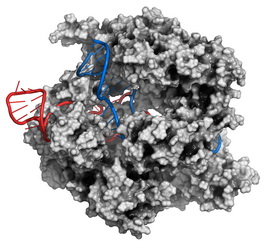
CROP BIOTECH UPDATE
---------------------------------------------------------------------------
A weekly summary of world developments in agri-biotech for developing countries, produced by the Global Knowledge Center on Crop Biotechnology, International Service for the Acquisition of Agri-biotech Applications SEAsiaCenter (ISAAA)
---------------------------------------------------------------------------
May 15, 2019
In This Week’s Issue:
News
Global
• G20 Ag Ministers Commit to Work Together for Global Food Security Based on Sound Science
• Sustainable and Pro-GMO Chocolates Now Available to the Public
Africa
• Farmers in Ghana Urge Government to Speed Up GM Crop Commercialization
• Nigeria Approves Two GE Cotton Varieties to Boost Supply
Americas
• Scientists Report Cereal Crop That Never Dies
• Tomato Pan-Genome Reveals 4,873 Undocumented Genes
• Experts Discover Plant Hormone that Speeds Growth
Asia and the Pacific
• Scientists Identify Genes to Combat Canola Blackleg Disease
Europe
• Defra Approves GM Camelina Field Trials
Research
• Effect of Drought Stress on Photosynthate Allocation and Remobilization in Common Bean Pods
New Breeding Technologies
• CRISPR-Cas9: Plant Breeding at the Speed of Light
• LSSR1 Facilitates Seed Setting Rate By Promoting Fertilization in Rice
• North America Genome Editing Market Projected to Increase by 2025
Beyond Crop Biotech
• Viruses Genetically Engineered to Kill Bacteria Rescue Girl with Antibiotic-Resistant Infection
----
NEWS
----
Global
G20 AG MINISTERS COMMIT TO WORK TOGETHER FOR GLOBAL FOOD SECURITY BASED ON SOUND SCIENCE
The Ministers of Agriculture of Argentina, Brazil, Canada, Mexico, and the United States have met in Niigata, Japan during the G20 Niigata Agriculture Ministers' Meeting on May 12, 2019, affirming their intent to work together for global food security and agricultural trade on the basis of sound science and risk analysis principles.
The top agricultural officials include Argentine Secretary of Agroindustry Luis Miguel Etchevehere; Brazilian Minister of Agriculture, Livestock, and Food Supply Tereza Cristina Dias; Canadian Minister of Agriculture and Agri-Food Marie-Claude Bibeau; Mexican Secretary of Agriculture and Rural Development Victor Villalobos; and U.S. Secretary of Agriculture Sonny Perdue. Together, they issued the following statement:
"Together, we stand to work in partnership, and jointly with additional countries, to support regulatory approaches that are risk- and science-based, predictable, consistent, and transparent. Our five nations recognize that innovations in the agriculture sector contribute to improved productivity, including by smallholder and young farmers, and rural women, in a safe and sustainable manner, and to our countries' ability to meet the ever-growing global demand for food. With the world's population projected to reach 9.8 billion by 2050, science and innovation will play a key role in enabling agriculture producers to safely feed everyone.
"As Western Hemisphere agricultural leaders, we affirm our intent to work together to champion global agricultural trade based on sound science and risk analysis principles. We also affirm our intent to allow farmers and ranchers access to the tools needed to: increase productivity; reduce food loss and waste; protect soil, water, and biodiversity; and produce safe, nutritious, affordable food products year-round, to the benefit of the world population."

For more details, read the USDA press release, or read the G20 Agriculture Ministers' Declaration 2019.
 After its successful debut in February, the sustainable and unabashedly pro-GMO Ethos Chocolate is again available to the public.
After its successful debut in February, the sustainable and unabashedly pro-GMO Ethos Chocolate is again available to the public.
Produced by A Fresh Look, a US-based family farmer-led nonprofit organization working to educate people about GMOs, Ethos Chocolate bars are created by artisanal chocolatiers at SPAGnVOLA and their family-run cacao farm in the Dominican Republic. However, unlike most chocolate lines in the market today, Ethos Chocolate tells a story -- that of the benefits and products of biotechnology.
The four varieties, aptly named The Optimist, The Survivor, The Hero, and The Trendsetter, are made of sustainably grown cacao and fruits which symbolize a GMO success story: papaya, apples, and oranges. These ingredients also accentuate the potentials of GM crops in solving food challenges across the globe.
The Ethos Chocolate can be availed by making a donation to A Fresh Look. Proceeds from the donations will benefit the family farmers and agricultural communities behind the production of the handcrafted chocolate bars.
For more information, read the news article in A Fresh Look.
Farmers in northern Ghana are calling on their government to speed up the commercialization of genetically modified (GM) crops in the country.
During a media briefing in Tamale, representatives of farmer groups under the coalition of Concerned Farmers of the Northern Region expressed their concern about the continuous decline of cotton and cowpea production in that part of the country. They attribute such decline to repeated pest attacks and are confident that GM crops will help them deal with such problems. The coalition includes the Northern Farmers Association, Juni Farmers Association, Northern Livestock Farmers Association, and the Northern Outgrowers and Business Association.
The coalition has released a press statement delivered by conveners Ibrahim Alhassan of the Juni Farmers Association and Nasiru Adams of the Northern Farmers Association. In their statement, the farmers said that "biotechnology as a scientific tool is not a killer, but one that is used to modify seeds genetically for our good. It provides efficient solutions, to the problems we the farmers of Ghana face in our daily operations in crop and other production activities."
"To the government of Ghana, we say act now and facilitate the commercialization of GM variety seeds especially cowpea and rice. Let the farmers have the GM variety alongside the conventional seeds, we are simply demanding for our right of choice."
Read the full press statement in GhanaWeb. A related story is available in Cornell Alliance for Science.
Two genetically engineered cotton varieties (MRC 7377 and MRC 7367) were approved in Nigeria for planting by farmers to help increase supply for the textile industry and cut lint imports, according to officials.
According to Rose Gidado, Assistant Director of the National Biotechnology Development Agency, the GE cotton varieties were developed by the Institute of Agricultural Research at the Ahmadu Bello University. They inserted a gene that makes the cotton plants resistant to bollworm attack, which is the most devastating pest in cotton production. Aside from pest resistance, the GE cotton varieties are also high yielding, increasing the usual output of conventional varieties to over threefold, with improved fiber strength and length.
At present, Nigeria produces 60,000 tons of cotton annually. With the introduction of new GE cotton varieties, it is expected that at least 150,000 tons will be produced by cotton farmers in the coming season.
Read more from Bloomberg and Genetic Literacy Project.
Researchers at The Land Institute reported about a crop with very small cereal grains but seems to be immortal, giving hope to the future of agriculture.
The crop, known as Kernza, is a hybrid derived from wheatgrass. It was developed by scientists to withstand the drastic effects of climate change. It is a penennial grain, which does not need to be replanted after harvest season, because the plant can regrow repeatedly while its roots grow deeper under the ground. This helps decrease soil carbon emission which occurs during harvesting and sowing of seeds.
To date, Kernza is planted on 500 hectares of land in Kansas. A food corporation made a breakfast cereal prepared from Kernza and also providing funding to Land Institute for large-scale production of the cereal crop. Another international company brewed a new kind of beer using Kernza. Food hubs in the U.S. are also using Kernza flour for pasta, bread, and pizza and the consumers' feedback is favorable.
Read more about Kernza from The Land Institute and Efforts for Good.
As tomato breeders focused on traits that improve production such as larger fruits and more fruits per plant, some traits for other qualities (flavor, disease resistance) were lost. Now, scientists from the USDA Agricultural Research Service (ARS) and the Boyce Thompson Institute (BTI) have created a pan-genome that captures all of the genetic information of 725 cultivated and closely related wild tomatoes, mapping 4,873 genes that were absent from the original reference genome.
The first tomato genome sequence was released in 2012, revealing approximately 35,000 genes and facilitating crop improvement efforts. Since then, several hundred additional tomato genotypes have been sequenced. The pan-genome helps identify additional genes that might be available for crop breeding and improvement. "One of the most important discoveries from constructing this pan-genome is a rare form of a gene labeled TomLoxC, which mostly differs in the version of its DNA gene promoter. The gene influences fruit flavor by catalyzing the biosynthesis of a number of lipid (fat)-involved volatiles—compounds that evaporate easily and contribute to the aroma," explained James Giovannoni, a BTI faculty member and USDA scientist.
The researchers found that TomLoxC also facilitates the production of a group of apocarotenoids—organic chemicals from carotenoids including vitamin A precursors—that work as signaling molecules influencing a variety of responses in plants including environmental stresses. The compounds also have floral and fruity odors that are important in tomato taste.
For more details, read the news releases from ARS and BTI.
Scientists from the United States and Saudi Arabia have identified beta-cyclocitral, a plant hormone that makes tomato and rice plants roots grow faster and branch more. Beta-cyclocitral speeds root growth when added to soil. A commonly found hormone in plants, it also makes rice plants resistant to salty soil.
The researchers wanted to find plant hormones that affected root development. Their previous research hinted that some molecules related to carotenoids might be important. Using Arabidopsis, the team tested about 20 carotenoids that have been repurposed and are available as food additives and found that beta-cyclocitral stood out. According to coauthor Jazz Dickinson, it is possible that the compound helped the roots push down through the salty topsoil to reach the deeper, less-salty soil more quickly.
For more details, read the news article at the Howard Hughes Medical Institute.
A team of scientists from the New South Wales Department of Primary Industries (DPI) in Australia took a closer look at the canola plant's genome and was able to detect multiple genes in eight regions of the genome that can be used to develop new canola varieties resistant to the blackleg disease.
After three years of studying the canola under field and greenhouse conditions, the scientists were finally able to identify the genes that can become a durable source with multigene resistance to the blackleg disease. Blackleg disease has been a problem in Australia since the 1970s. It is caused by a fungus whose pathogen is highly diverse. On a global scale, blackleg disease remains a threat as well.
According to lead research scientist Dr. Harsh Raman, it is important to continuously seek and discover new sources of major and quantitative resistance in canola to minimize yield loses. Major resistance genes are helpful, but do not offer long-term protection to canola plants because of the blackleg pathogen's ability to mutate and render the major genes ineffective over time. Quantitative resistance, on the other hand, is difficult to select and is complicated by environmental factors. Thus, molecular markers linked with resistant loci could be used to enhance blackleg resistance in canola germplasm.
These new findings can then become the basis for other scientists to produce elite varieties of canola with quantitative resistance, providing canola longer-lasting protection against the blackleg disease.
Read DPI's media release and the full paper to know more.
 The United Kingdom's Department for Environment, Food and Rural Affairs (Defra) has given permission for Rothamsted Research to run a series of field trials using genetically modified (GM) Camelina plants.
The United Kingdom's Department for Environment, Food and Rural Affairs (Defra) has given permission for Rothamsted Research to run a series of field trials using genetically modified (GM) Camelina plants.
This permit follows previous GM Camelina trials carried out by Rothamsted in 2018. The first part of the research will determine field performance and the seed oil yield of GM Camelina plants engineered to accumulate omega-3 fish oils in their seeds. The second part will look at the performance of Camelina plants whose metabolism has been altered to increase seed oil content. The final part will look into the performance of Camelina plants engineered to contain less sinapine in their seeds. Sinapine is a bitter-tasting, antinutritive chemical that makes the protein-rich seed meal less palatable as an animal feed.
A recent study led by the University of Southampton found the uptake and use of these oils by the human body was the same whether plant or fish-based sources were consumed. A collaboration with the University of Stirling and Norwegian University of Science and Technology showed that these GM oils were an effective substitute for fish oil in the feeds of farmed salmon.
For more details, read the news release from Rothamsted Research.
Common bean is the most important staple grain legume for direct human consumption because of its high nutritional value. To maximize its nutritional potential, scientists aimed to improve its resistance to various stresses. Previous studies showed that photosynthate remobilization and partitioning is one of the major mechanisms of drought tolerance and overall productivity in common bean. Thus, scientists from the University of California, Davis aimed to determine the inheritance of pod harvest index (PHI) a measure of the partitioning of pod biomass to seed biomass, relative to that of grain yield. Their findings are reported in BMC Plant Biology.
The researchers assessed a recombinant inbred population of the cross of ICA Bunsi and SXB405, to know the impact of intermittent and terminal drought stresses on the genetic architecture of photosynthate allocation and remobilization in pods of common bean. The population was grown for two seasons, under well-watered conditions and terminal and intermittent drought stress in one year, and well-watered conditions and terminal drought stress in the second year.
Results showed that there was a significant effect of the water regime and year on all the traits, at both the phenotypic and quantitative trait locus (QTL). They identified 9 QTLs for pod harvest index, 8 QTLs for yield, 3 of which clustered with PHI QTLs, confirming the importance of photosynthate remobilization in productivity. Substantial epistasis was also found, explaining a considerable part of the variation for yield and PHI. The findings show the genetic linkage of PHI and yield and confirm the role of PHI in the selection of both additive and epistatic effects controlling drought tolerance.
Read more findings in BMC Plant Biology.
Experts from Karlsruhe Institute of Technology in Germany described the CRISPR-Cas9 system and its ability to generate directed genetic diversity at multiple sites. They referred to the system as a tool for plant breeding at the speed of light. The review article is published in BMC Plant Biology.
According to Felix Wolter and co-authors, conventional plant breeding methods have successfully generated high yielding crop varieties. However, the long process of development has impoverished the genetic diversity available for breeding. With the CRISPR-Cas9 system, there are new opportunities to improve genetic diversity like never before. Because of its multiplexing ability, multiple targets can be modified at the same time efficiently, allowing immediate pyramiding of several desired traits into an elite background within one generation. Through targeting regulatory elements, a selectable range of transcriptional alleles can be generated, which allows precise fine-tuning of desirable traits. Furthermore, targeting homologues of so-called domestication genes within one generation, will catapult neglected, semi-domesticated and wild plants quickly into the focus of mainstream agriculture.
Read the review article for more details.
The seed set, which pertains to the number of seeds per pollinated flower, is one of the vital components that determine rice yield. Successful fertilization is important for normal seed setting, but there is limited knowledge about the molecular mechanisms controlling this process. Scientists from the National Rice Research Institute in China reported a novel rice gene, LOW SEED SETTING RATE1 (LSSR1), which controls the seed setting rate through rice fertilization. The results of their study are published in Rice.
According to the study, LSSR1 codes for a GH5 cellulase, which is highly conserved in plants. To investigate the physiological role of LSSR1 in rice, the CRISPR-Cas9 system was used to develope loss-of-function mutants of LSSR1. Results showed that the morphology of the vegetative and reproductive organs looks normal in the mutant lines. Analysis of the cells showed that the impediment of fertilization caused low seed setting rate in lssr1 mutant lines, probably due to abnormal pollen germination, failed pollen tube penetration, and retarded pollen tube elongation.
The results of the study suggest that LSSR1 has a vital role in rice fertilization, which leads to maintaining good rice seed setting rate.
Read the research article in Rice.
 The North America genome editing market is expected to reach US$ 4,148.1 million in 2025 from US$ 1,234.5 million in 2017. The market is estimated to grow with a compound annual rate of 17.2% from 2018-2025. These are according to the latest forecast released by Research and Markets.
The North America genome editing market is expected to reach US$ 4,148.1 million in 2025 from US$ 1,234.5 million in 2017. The market is estimated to grow with a compound annual rate of 17.2% from 2018-2025. These are according to the latest forecast released by Research and Markets.
The rise of the genome editing market is primarily attributed to the increased adoption of GM crops and the increasing prevalence of genetic diseases. However, the strict regulations implemented on genome editing may cause a negative effect on market growth. In 2017, the CRISPR segment held the largest market share of 53.6% of the genome editing market, by technology. This segment is also expected to dominate the market in 2025 owing to the simple, fast and accurate property of the CRISPR. Moreover, the TALENs segment is anticipated to witness the significant growth rate of 17.1% during the forecast period, 2018 to 2025 owing to the properties provided by TALENs, expecting the market to rise in the near future.
It was also mentioned in the report that the genetic engineering segment of the North American market is expected to grow at a significant rate due to the adoption of animal and plant genetic engineering products.
Read more from Research and Markets.
Seventeen-year-old Isabelle Carnell has battled a drug-resistant infection of Mycobacterium abscessus for half her life. In 2017, a week after a double lung transplant, the incision wound turned bright red and was rapidly spreading, erupting in weeping sores and swollen nodules across her frail body.
Helen Spencer, Carnell's physician decided to take a gamble on what seemed like a far-fetched idea: phages, viruses that can destroy bacteria and have a long—if checkered—history as medical treatments. Spencer collaborated with leading phage researchers, who concocted a cocktail of the first genetically engineered (GE) phages ever used as a treatment—and the first directed at a Mycobacterium, a genus that includes tuberculosis (TB). Six months after the tailor-made phage infusions, Isabelle's wounds healed and her condition improved with no serious side effects.
Spencer's team worked with phage researcher Graham Hatfull of the University of Pittsburgh in Pennsylvania. Hatfull and his team curate a collection of more than 15,000 phages, one of the world's largest. The team spent three months searching for phages that could kill M. abscessus isolated from Isabelle's wounds and sputum and found three.
For more details, read the news article in Science.